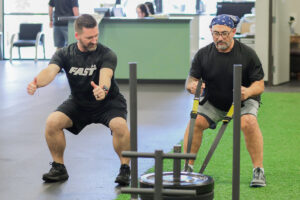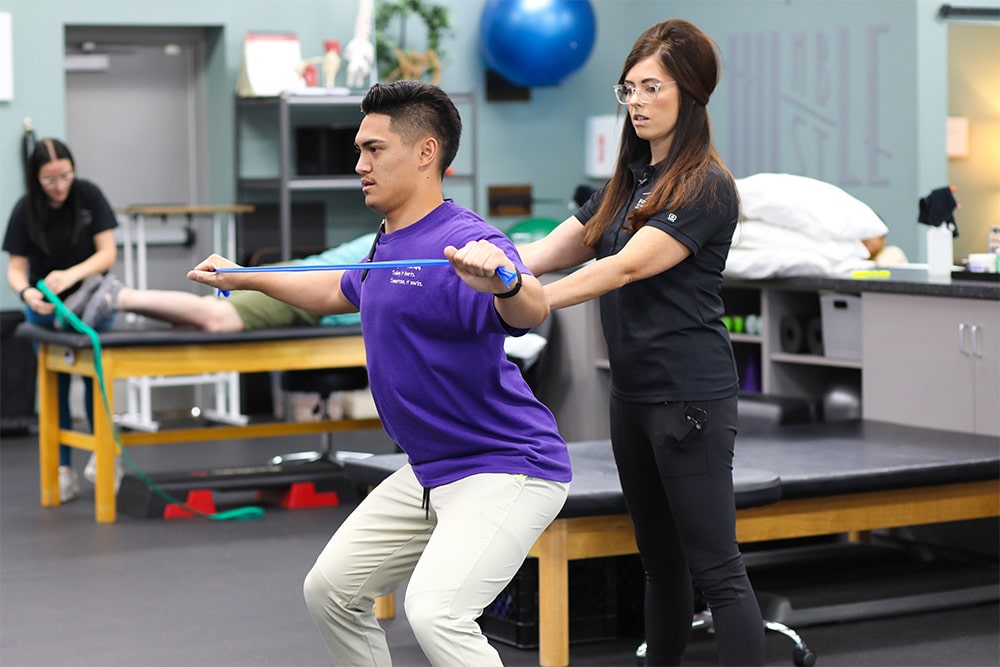Committing to your health and rehabilitation journey demands time and effort, and we are here to support you every step. Our primary goal is to assist you in reaching a full recovery and helping you get back to the life you love quickly! To ensure you get the most out of your Physical Therapy (PT) experience, here are some valuable tips to consider:
1. Be Prepared
Arrive on time for your sessions so you have more time with your therapist and technician to work through your treatment plan.
Dress in comfortable, loose-fitting clothes for stretching. Sessions are usually performed in the gym, where you may be neighboring with other patients.
2. Ask Questions
Take at least 10 minutes daily to write down any questions or concerns you may have the night before to discuss any challenges with your therapist at the next session.
Asking questions demonstrates active engagement in your recovery. When you ask questions, you are more likely to gain insights, learn coping skills, and make positive changes in your life. This, in turn, can lead to a more favorable recovery outcome.

3. Follow Your Physical Therapy Home Exercise Program (HEP)
You may have a home exercise program (HEP), depending on your treatment plan. This is your PT homework that will be provided to you by your physical therapist or tech at the very beginning of your sessions. Doing these exercises regularly is important to maintain and improve your gains.
Patients who routinely do their exercises and integrate the corrections given to them far excel those who do them on occasion. Please ask if you need clarification on whether you’re doing an exercise correctly. We are here to answer any of your questions to help promote a regular exercise routine. That said, when you have graduated from PT, it is routine practice to keep up with your HEP, as you will continue to see improvements well past your last visit.
4. Be Consistent with Your Physical Therapy Sessions
Physical Therapy sessions work by building upon each other, and when you are consistent, the exercises will progress function and help you achieve your goals quicker.
- Physical therapy is a process that takes time and effort. The more consistent you are with your sessions, the better your results will be.
- When you are consistent with your physical therapy, you can see your progress over time. This can help you to stay motivated and on track to reach your goals.
- Physical therapy helps strengthen your muscles and improve your range of motion, which reduces your risk of re-injuring yourself.
- Staying consistent with your sessions can keep your pain under control and improve your quality of life.
5. Communicate
Be honest and open with your therapist. Let them know how you’re feeling, both physically and emotionally. This will help them to tailor your treatment plan to your individual needs.

6. Integrate Personal Training with Physical Therapy
Personal training can be a great way to maximize the benefits of physical therapy and achieve your fitness goals. Working with a personal trainer can help you maintain an active lifestyle and keep you accountable for your HEP.
Once you have completed your physical therapy program, you may need support in maintaining the results from PT so that you are less likely to get re-injured. Foothills Sports Medicine Physical Therapy created FAST Performance Training to facilitate a seamless transition from injury recovery or surgery to an active, healthy lifestyle.
7. Track Your Physical Therapy Progress
Tracking your progress can help you identify areas you need to improve. Tracking your progress can help you to identify and celebrate your successes, no matter how small they may seem.
8. Know Your Insurance Plan
Understanding the specifics of your coverage can help ensure you have a clear picture of what to expect when seeking physical therapy or other medical care. Being well-informed about your insurance plan can transform the physical therapy experience from a potentially stressful ordeal into a straightforward and manageable part of your healthcare journey. It empowers you to focus on your recovery and well-being rather than worrying about “surprise” bills.

9. Get Adequate Sleep
You could train for hours and hours, but if you don’t get adequate sleep, you will not see the best results possible. For example, if you are recovering from a knee injury, sleep is essential for healing the damaged tissues and reducing inflammation. If you are managing a chronic condition, such as arthritis, sleep can help to improve your symptoms and function.
Most adults need around 7-8 hours of sleep per night. However, depending on their needs, some people may need more or less sleep. Talk to your doctor if you are still determining how much sleep you need.
10. Eat Well
What we eat while healing can impact our recovery time frame, change our mood, and fuel the body for recovery. Food should be viewed as a power source for our bodies. Good nutrition for recovery is essential for achieving a speedy and complete recovery.
Foothills Physical Therapists are here to guide you on your journey to recovery and improved well-being. If you have any questions or need further guidance, don’t hesitate to reach out to your therapist. If you are wondering if physical therapy is right for you, schedule a FREE assessment today at a Foothills location near you.




